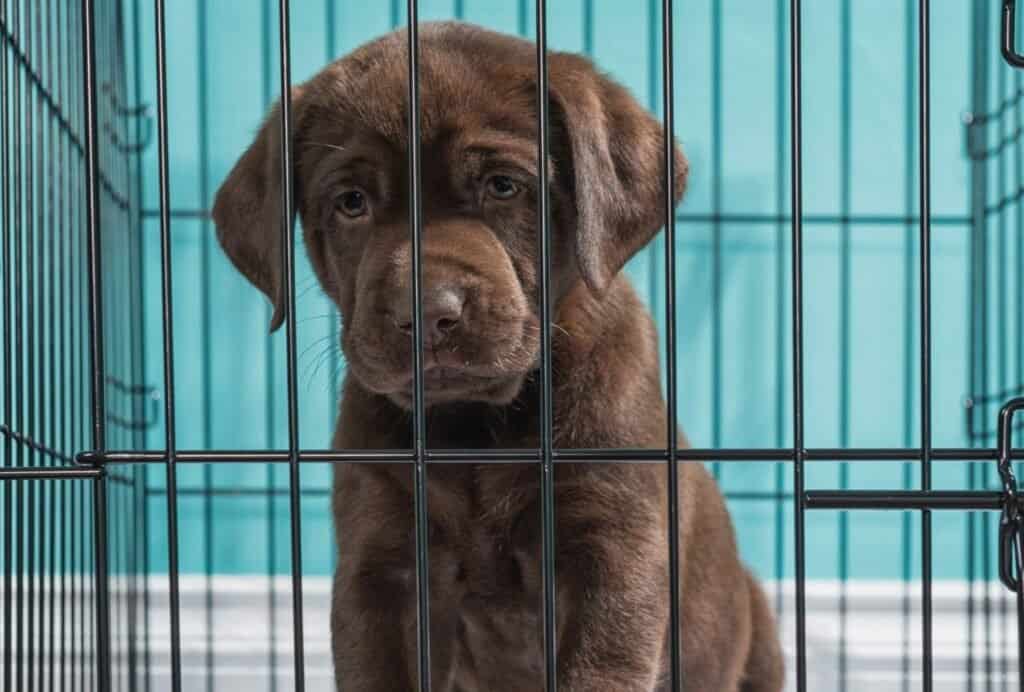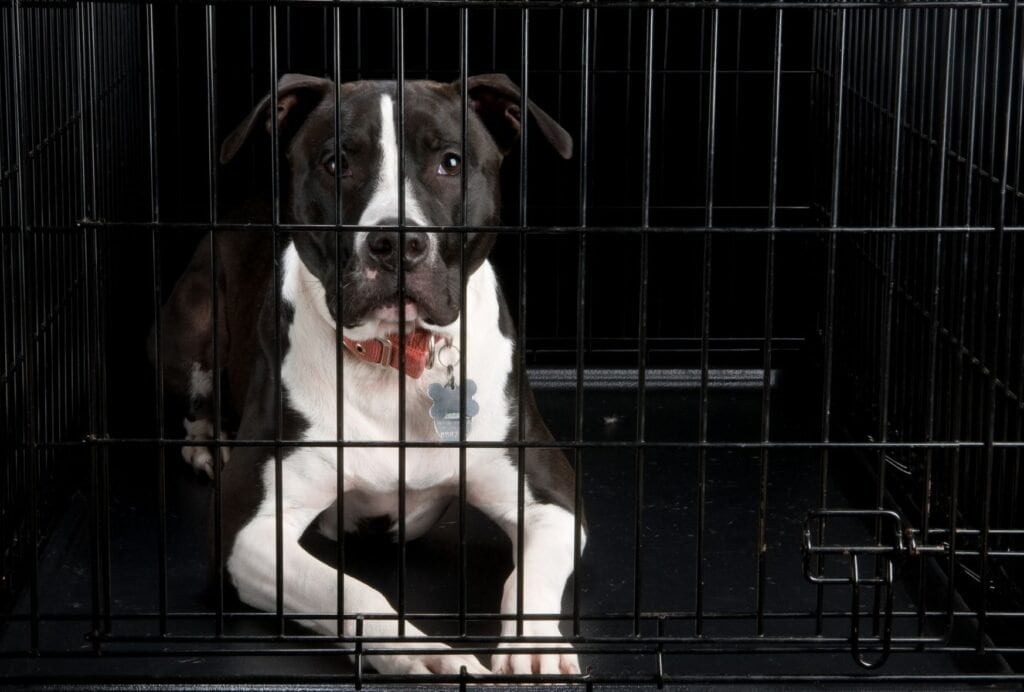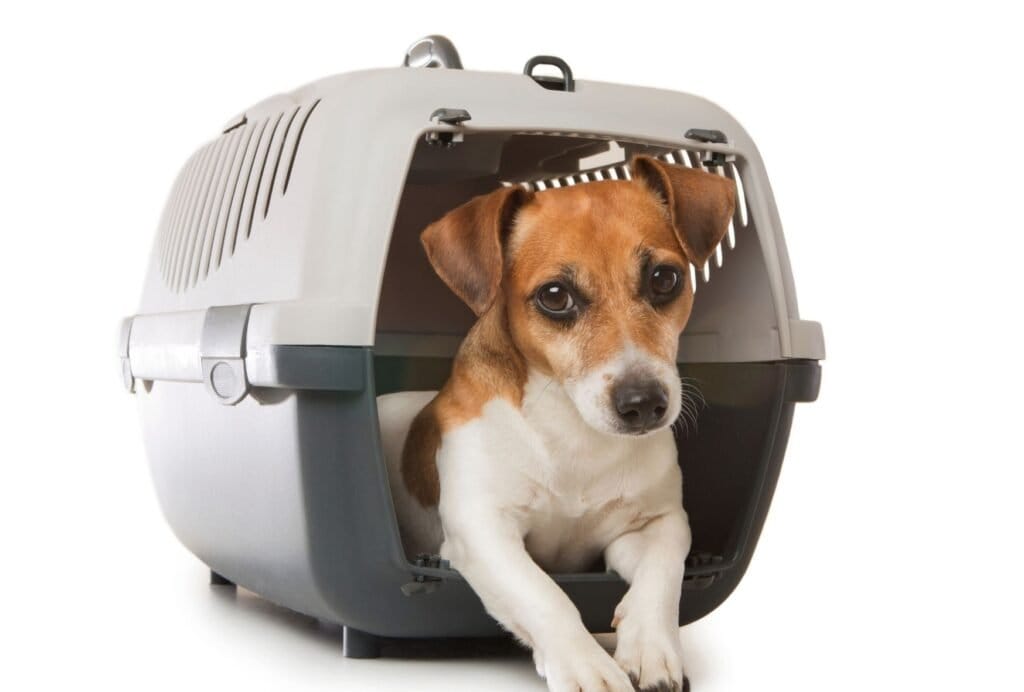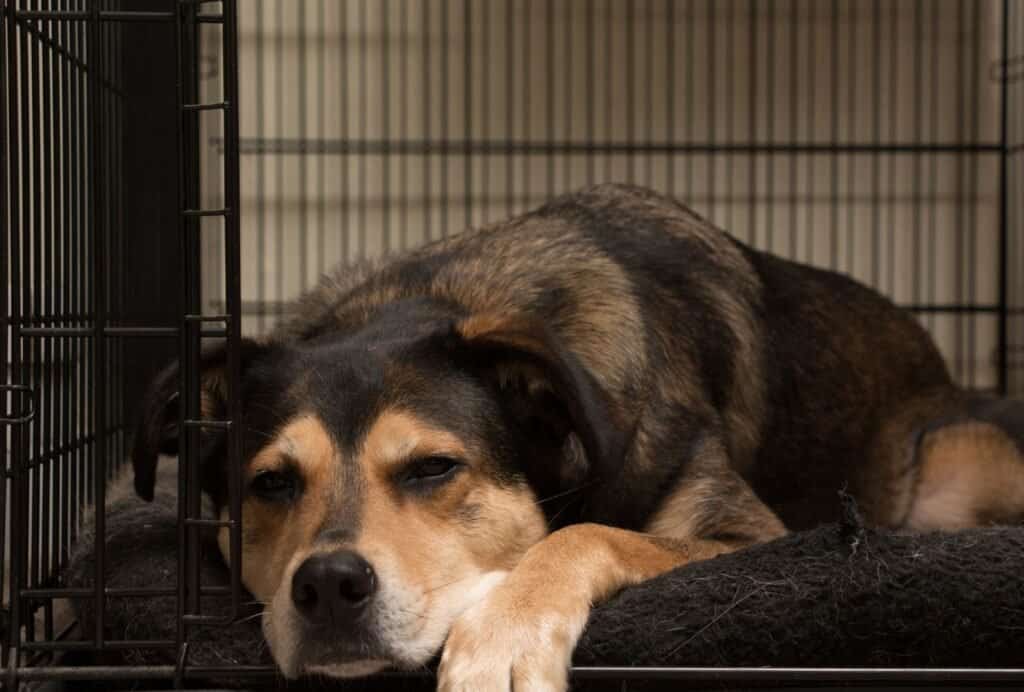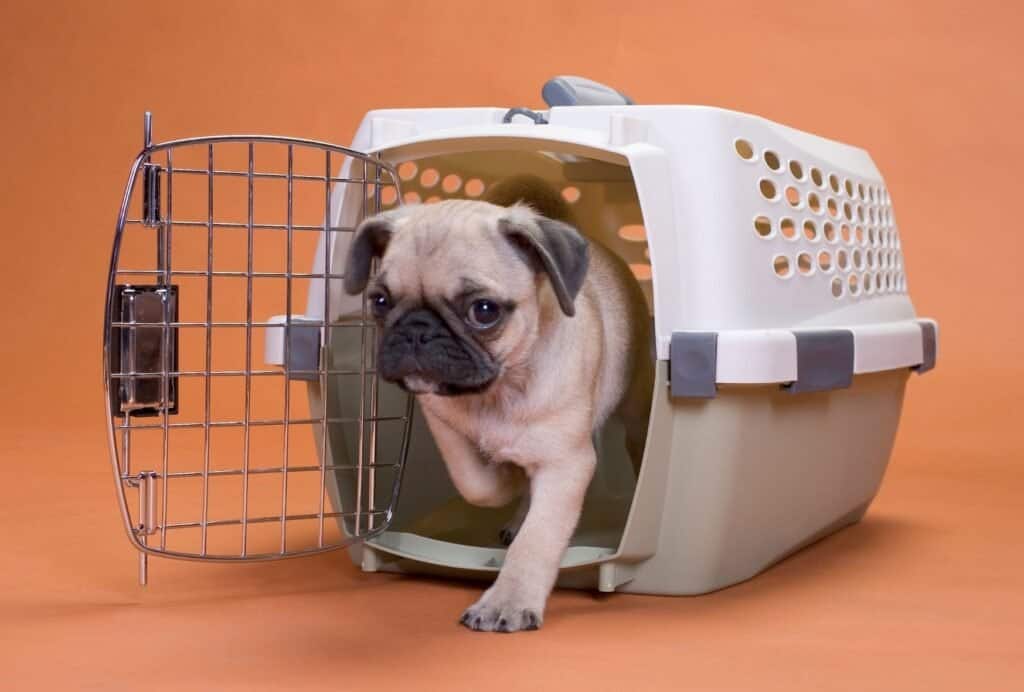Does your dog hate his crate?
Don’t worry, you’re not the only one in this situation. I remember that Baloo was not very fond of his crate in the beginning, either. He was super high-energy and suffered from severe separation anxiety.
So, even having him in his crate in a different room was a disaster every time. Luckily, I got him to love it at some point.
It took a lot of time, patience and love but we got there.
If your dog currently hates his crate, then this article is for you! We’ll first go over why some dogs hate their crates. And then I’ll show you how you can make him love it again.
Table of Contents
My Dog Hates His Crate – Why Is That?
Crate training is one of the best things you can do for your dog—especially a hyper one! They’re great places for your puppy to rest, settle down, and feel safe.
But while some dogs are able to take to their crates quickly, others have a much harder time and might even develop a so-called dog crate anxiety.
If your dog is protesting, barking, crying, and refusing to go into his crate, there are a few possible reasons why he might hate it.
He’s Not Properly Crate Trained
The very first step to getting your dog to love his crate is to make sure he’s crate trained the right way.
Your dog’s crate should be somewhere that he goes to feel comfortable and safe. When he goes in there, he should be thinking, “Oh, this is my little corner all to myself where I get to relax.”
Unfortunately, many dog owners don’t know how to crate train their dogs properly. Doggy parents may think of the crate as a tool for punishment rather than a place your dog should go to be comfortable.
If you’re only using the crate to punish your dog, then of course he’s not going to like it!
He’s Had an Accident Inside the Crate
If your dog has peed or pooped inside his crate, then he’s probably not going to want to stick around in there. Just imagine having to sleep in your own mess… yuck!
In case your dog is still working on house training, then it’s natural that he may have an accident or two—even inside his crate.
If he does have an accident, it’s important to clean everything up thoroughly. Dogs have an incredibly strong sense of smell and can pick up on lingering scents if you haven’t cleaned up well enough.
He’s Anxious or Stressed
Depending on the dog, they may or may not take to their crates right away. Crate training plays on a dog’s den instinct, but some dogs’ den instincts are stronger than others.
If your dog has developed crate anxiety, then it could be that being alone in his crate is stressing him out.
He Learned that Crying Gets Him Out
Dogs learn best by positive reinforcement. So what is positive reinforcement dog training?
Well, in essence it’s rewarding behavior you like while ignoring behavior you don’t.
Unfortunately, sometimes we accidentally reward the wrong behavior. If your dog cries in his crate and as soon as he starts you let him out, that’s reinforcing crying as a behavior. The reward is that your dog gets out of his crate!
If your dog is crying in his crate, it’s best to wait until he stops before you let him out. That teaches him that being calm and quiet is the best way to get what he wants.
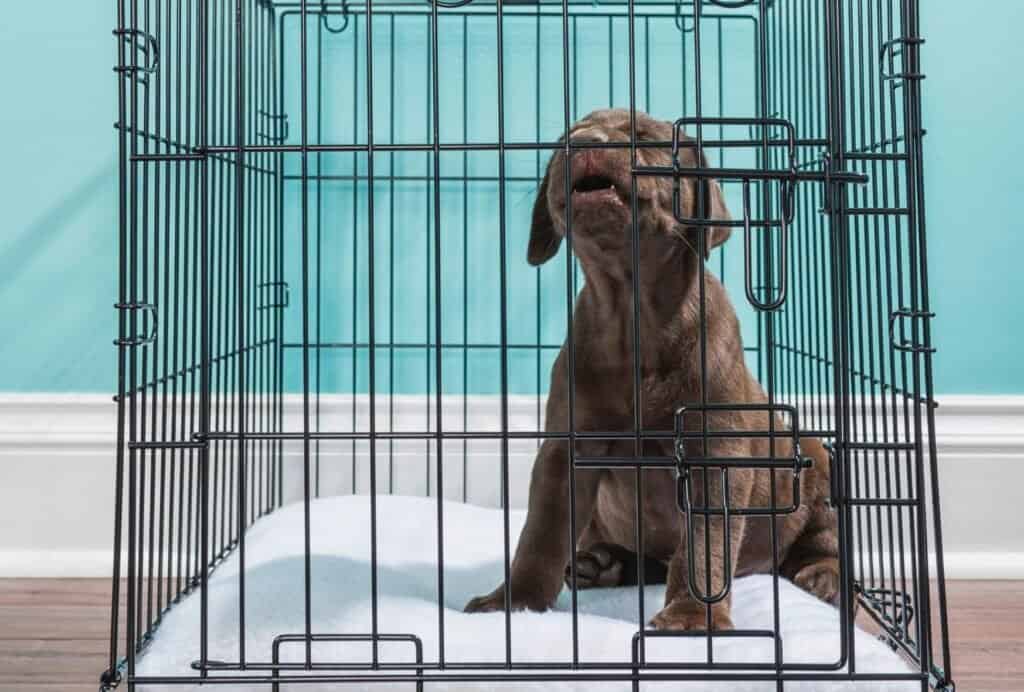
How Do I Get My Dog to Like His Crate?
You might be wondering: Ok, so how do I fix my dog’s crate anxiety? Or you might be more frustrated (like I used to be) and think: How do you I get my dog to stop crying in his crate?
So here are a few tips to help your dog like his crate.
Crate Train Him Properly
The number one thing to do is make sure that you’re crate training your dog properly. The goal of crate training is for your dog to feel comfortable in his crate.
I already have a detailed guide about how to crate train a dog, so make sure to check that out.
Do you have an older dog? Don’t worry—it’s totally possible to crate train him successfully too! Here’s how to crate train an older dog in 6 steps.
Make Sure He Gets Enough Mental and Physical Stimulation During the Day
A lot of the time, dogs act out because they have too much excess energy in their bodies. It’s really important to make sure that your dog is getting enough physical activity during the day.
The amount of exercise that an individual dog needs will vary based on their age, breed, health, and overall personality. If you’re not sure how much exercise your dog needs, you can always check in with your vet.
Going for walks, hikes, and joining dog sports are great ways to burn some of your dog’s physical energy.
But you don’t want to forget about your dog’s brain! For a little inspiration, here are 10 brain games for dogs to play at home.
Give Him Something to Lick or Chew Inside the Crate
When dogs lick or chew things, it releases a hormone in their brain called serotonin. This hormone makes you feel calm and content.
Since you want your dog to have positive associations with his crate, it’s a really good idea to get his brain producing more serotonin!
Keeping his mouth and nose busy will also distract him from crying or barking in the crate.
One awesome thing you can try is filling up a Kong toy with treats and sealing it with some peanut butter. Then put it in the freezer for a few hours and give it to your dog when it’s crate time.
Cover the Crate to Make It More Like a Comfy Den
In the wild, wolves and dogs will dig little burrows to use as their dens. As you can imagine, these burrows are pretty dark.
If your dog is having trouble settling down in his crate, you can cover it up with a sheet or a blanket. Making it darker might help your dog associate his crate with a cozy little den!
How Long Does It Take for a Dog to Get Used to a Crate?
If only there were a universal answer to this question! You could mark on your calendar exactly when your dog is going to be 100% happy to head into his crate.
Unfortunately, no universal answer exists. All dogs are different! Some dogs get used to their crates in just a few days, while others may take weeks—or even months! I think it took me at least 2 or 3 months until Baloo was more or less comfortable in the crate…
But as long as you stay patient and consistent and build up your dog’s positive associations with his crate, he’ll get used to it.
And not just that—he’ll learn to love it too!
Should I Force My Dog into His Crate?
No, definitely not!
You should never force your dog into his crate!
Remember, you want to build up positive associations. Shoving your dog into his crate isn’t going to do that!
If your dog is reluctant to go into his crate, try luring him in with treats, his favorite toys, and feed him his meals in there. When you make all the best things happen in the crate, your dog will be much more willing to go in on his own!
Dog Hates Crate – Specific Situations
If your dog only seems to hate the crate at night or suffers from separation anxiety in general, you might wonder if you need to act differently to fix your dog’s crate anxiety. Let’s look at a few specific situations.
My Dog Hates His Crate at Night
If your dog is throwing a fit when it’s time to go to his crate for bedtime, then he may be a bit too riled up for sleep.
Make sure that you’re giving your dog enough stimulation during the day, and keep the room he’s in for bedtime dark and quiet.
For some more tips, here’s how to calm a puppy down for bed.
My Dog Hates His Crate all of a Sudden
Your dog might seem like he hates his crate all of a sudden, but there’s usually a little more to it than that.
Dogs thrive when they have routines. And if their routine gets switched up, they may have a hard time dealing with that change.
For a more in-depth answer and some tips, check out “Your dog suddenly hates his crate? Do this!”
How to Crate Train a Dog with Separation Anxiety
Separation anxiety can be really challenging for both you and your dog to deal with. The first piece of advice for those whose dogs struggle with separation anxiety is: don’t blame yourself! Many dog owners think their dog’s separation anxiety is their fault, which only makes them feel worse!
Training an anxious velcro dog may require some extra work, but you can do it! Here’s our detailed guide on how to crate train a dog with separation anxiety.
Conclusion
Your dog’s crate is a really great tool for both of you. But if your dog doesn’t like his crate, that makes it hard to use it effectively.
But don’t worry—if your dog hates his crate, there are ways you can help him get used to it and even learn to love it.
You may not be able to find a quick fix to the issue, but with time, patience, and consistency, you’ll be able to help your dog learn that his crate is somewhere he can go to be safe and comfortable.
*Disclosure: This post may contain affiliate links, meaning, I get a commission if you decide to make a purchase through one of my links, at no cost to you.

